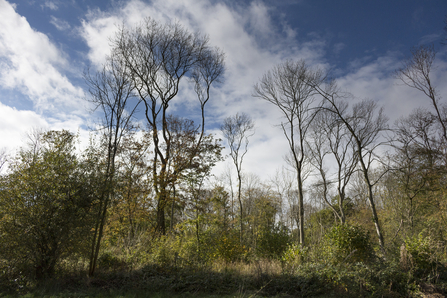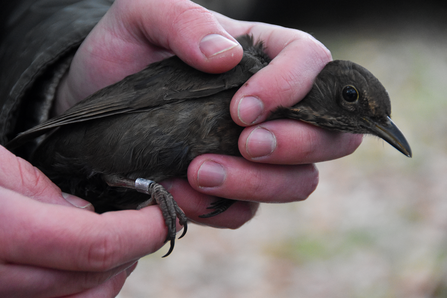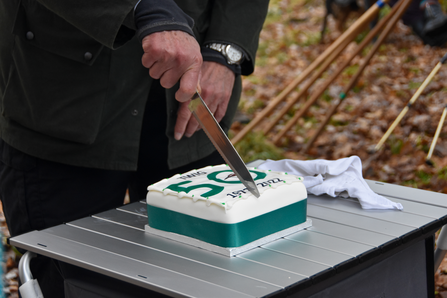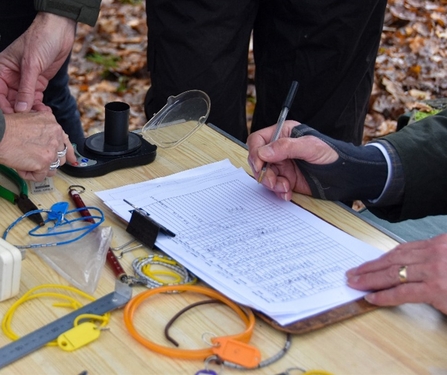Luckily for me, since I am new to the Trust, my first few months have included visiting and getting to know as many of our reserves as I can! Having recently visited our ancient woodland reserve Ploughman Wood and learning about the work we do there, I was excited to visit another. Treswell Wood was the first nature reserve to be purchased by Nottinghamshire Wildlife Trust in 1973, so it is steeped in history, as well as being one of the best examples of an ash/oak/ maple wood in the county.
B'ringing' in the 51st year of Treswell Bird Ringing Group
Treswell bird ringing 50th anniversary cake © Sophie Bell

Treswell Wood © Michael Walker
The first thing that struck me when entering Treswell Wood was just how peaceful it was - it felt a world away from the bustling city centre (which in fact is only a 45-minute drive away). Breathing in the fresh winter air and walking along the frosty path was just what I needed on a Sunday morning!
When we reached the Treswell Wood IPM Group, it felt like we were entering into a little community in the woods. We were greeted with a smile and a hot drink, and with plenty of birds around to admire – what more could you want! I noticed quite a few visitors coming along to watch the bird ringing process, including children, and they were welcomed with open arms and enthusiasm.
Within the first half an hour of arriving, I was able to see an enchanting array of birds up close; blue tit, great tit, long tailed tit (my personal favourite), blackbirds, song thrush and goldcrest to name a few. The goldcrest is our smallest bird in the UK, and the individual we saw weighed a minuscule 5g - that’s the same as a 20p coin. How remarkable, I thought, that something so tiny can keep itself alive and warm enough in the current freezing temperatures (especially when I was struggling myself, wrapped in 4 layers).

Female blackbird © Sophie Bell
It struck me just how passionate every individual in the group was, and their commitment and enthusiasm toward getting the job done, even in the cold! The way they still found the time to include visitors and explain what they were doing amongst their work was incredible and extremely interesting. I can only imagine how much someone would learn if they attended the group regularly.
The whole process of bird ringing was extremely smooth and time efficient, with a timer being set to ensure the net was checked regularly and birds quickly processed to then be let go. The process includes extracting birds from the temporary mist nets where they are caught, carefully placing them into bags, then removing them to collect data including weight and wing length, fitting a small metal ring to new birds before they are then swiftly released (pun intended). The bags were only used once as an extra precaution against avian flu.
Since working at the Trust, I have become aware of species I never knew about before, including the adorable long-tailed tit. Since discovering them, I have made it my mission to see them whenever I embark on a walk – so you can imagine my excitement when one was removed from a bag, then another, and another…and before I knew it, it was long-tailed tits galore! This is because they form flocks of about 20 or more birds during the winter, so usually if one is caught in the net, a few more will follow. Uniquely with these birds, because they are already in groups, they can be kept in the same bags whilst waiting to be processed, which also helps them to keep warm as they can snuggle up together as they normally would at night. Any other birds would be extremely aggressive towards one another if kept in the same bag!

Long-tailed tit © Bob Coyle
Apparently, blue tits are especially feisty towards people too, and aren’t opposed to a good nip or two when being ringed!

Treswell bird ringing 50th anniversary cake © Sophie Bell
I was here for the 50th Anniversary after all, so of course this celebration deserved a fabulous cake! The group is so clearly special to a lot of people, who have continued to come along for many years. The group was first spearheaded by former Chairman of Nottinghamshire Wildlife Trust, John McMeeking MBE in 1978 and has continued to inspire generations of people ever since.
Peter Kirmond made the trip to the session, as he no longer lives nearby but was one of the first members of the group in 1978…
“The group sent me an email a couple of months ago saying, just to let you know, tomorrow is the 48th anniversary of the first time you appeared on the ringing records at Treswell Wood! I grew up in Retford, and I was dragged out to do all sorts from a very early age. I ended up being introduced to John McMeeking when I was about 16 and started ringing. He was an inspiration to a lot of people."
Research into survival rates, migration patterns, health of populations, morphology and life history traits can all be informed through ringing. The group’s invaluable data has produced many publications over the years, including particularly significant publications showing that constant effort techniques could measure juvenile abundance; Wren survival is density dependent; Treecreeper mortality is greatest in winters which were both cold and wet; and how coppice age relates to bird use.

Collecting and noting data © Sophie Bell
All in all, the energy at this event was incredibly positive and inspiring, and everyone there was obviously so passionate about the group and their work. It was wonderful to hear all of their stories, with one in particular standing out to me from a gentleman named Tom Oxley.
“I first discovered the group through a Nottinghamshire Wildlife Trust event at Treswell Wood, where I asked if I would be able to bring my four grandsons along to a session. I have since brought them along multiple times, and they are fascinated by the birds and the whole process of bird ringing. Despite the early starts when I took them in spring and summer, they are all keen for me to bring them again!”
I found it astonishing how this passion and interest from the group has been passed on to Tom, then his grandchildren and led to their interest in the subject and could potentially lead to being their career one day… all stemmed from one event.
It's a process for all ages to enjoy, with the most recent recruit Joe having recently graduated from university with a degree in Zoology.
“I started volunteering here in the summer, to stay involved with nature alongside my job. Everyone is really friendly and keen to pass along their knowledge.”
Get involved
The group is looking for new volunteers, so if you would like to be involved in their next half century of inspiration and incredible contribution to research click below!






